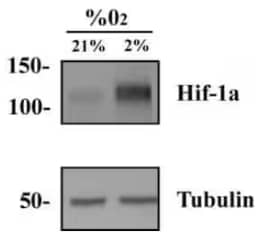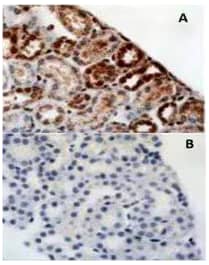Tips on positive and negative controls for HIF-1alpha antibodies is one of the most Frequently Asked Questions on Hypoxia and HIFs. Here are our top 5 suggestions:
1. The degradation of HIF1 alpha is the most common issue which often results in either a weaker specific signal and/or the appearance of multiple degraded protein bands in Western blot (WB). Degradation may be avoided by preparing the lysates quickly (on ice/at 4˚C) after the collection of cells or tissues, preferably in a hypoxic chamber. For differentiating the target band from degradation (40-80kDa) or dimer (200+ kDa) bands, we suggest including a control based on true hypoxia or hypoxia mimetic samples (e.g. cells treated with CoCl2). Bio-Techne offers the following ready to use lysates for HIF-1 analysis.

HeLa Hypoxic/Normoxic Lysate
[NBP2-36452]
WB analysis of HeLa hypoxic and normoxic lysates using HIF1 Alpha antibody (NB100-134). Hypoxic lysate showed several folds higher signal vs normoxic samples.

HIF-1 alpha Protein
[NBC1-18422]
IHC-P analysis of mouse kidney showing (A) staining with HIF-1 Alpha antibody NB100-479 and (B) NBC1-18422 as blocking control for NB100-479 (Images by: Dr. Yves Heremans).
2. With Immunocytochemistry-Immunofluorescence (ICC-IF) and Immunohistochemistry of paraffin sections (IHC-P), the fixation should be carried out by keeping the plated cells or tissues at 4˚C completely covered with/immersed in 4% paraformaldehyde or any other fixative. When performing IHC on frozen sections (IHC-Fr), the tissues may be snap frozen in liquid nitrogen or may be fixed immediately as described above for IHC-P. Any delay in the fixation step or fixation at room temperature may result in the degradation of HIFs which will lead to decreased or mis-localized signal. With ICC-IF, samples from cells exposed to hypoxic conditions or CoCl2 may be used as a positive control. In IHC of HIF-1 alpha, the recommended positive controls are the sections from Kidney Tissue/Heart Tissue or tumor Tissue Microarrays (TMAs), such as Human Cancers TMAs [NBP2-30262; NBP2-30328].
3, For immunostaining assays (ICC-IF and IHC), it is highly recommended to include at least one set of Secondary Only Control (no primary antibody added). This control helps to determine the specificity and the source of the signal. No staining in the secondary only control means that the staining is specific and is originating from the primary antibody only.
4. A peptide or protein based competition control (Peptide Competition Protocol) is another measure which can be employed for checking the specificity of the signal in immunostaining or for differentiating the target band from additional bands in WB. However, it is critical to compare the sequence of the peptide/recombinant protein being used for blocking to the immunogen of the antibody before pairing them for the blocking experiment. For example, HIF-1 alpha Protein [NBC1-18422] is compatible with HIF-1 alpha Antibody [NB100-479], but not with other HIF-1 Alpha Antibodies such as NB100-105 or NB100-131.
5. Isotype Controls are another critical type of negative controls (especially in IP, FLOW, IHC and ICC-IF) which aid in differentiating the non-specific signal from the specific primary antibody related signal. Isotype Control Antibodies lack specificity to the target under study but match the class/subclass and type of the primary antibody under study.
Compiled by: Subhash Gangar